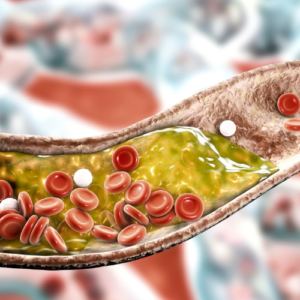Weight, Heart and Circulatory Diseases
Heart and circulatory diseases kill 1 in 4 people in the United Kingdom. Being overweight can lead to fatty material building up in your arteries (the blood vessels that carry blood to your organs). If the arteries that carry blood to your heart get damaged and clogged, it can lead to a heart attack. If this happens in the arteries which carry blood to your brain, it can lead to a stroke.
Carrying weight around your middle can also affect the way your body works. It can make it harder for your body to use a hormone called insulin, which regulates your blood glucose (sugar) levels. This can lead to Type 2 diabetes. Having high levels of glucose in your bloodstream for a long period of time can damage your arteries and increase your risk of heart and circulatory diseases. Being a healthy weight is about watching your portion sizes, gradually swapping some unhealthy items for healthier ones and moving about more. It’s important not to view these changes as a short-term diet. It’s a permanent lifestyle change that will protect you from serious illness.

Everyone needs some fat to stay healthy. But too much fat, particularly around the waist, puts your health at risk.
We have different types of fat in the body. Subcutaneous fat sits just below the skin, so we can often feel it. This is the kind of fat people tend to worry about. But actually it’s the hidden fat wrapped around your organs, called visceral fat, that presents the bigger health risk.
Visceral fat can affect how your hormones work and can:
• Raise your blood cholesterol
• Increase your blood pressure
• Reduce your body’s ability to use insulin,
increasing your risk of developing Type 2 diabetes.
A larger waist measurement is often a sign that you have too much visceral fat. You can reduce visceral fat by eating healthily and being physically active.
Visceral fat is stored around and between your internal organs in your abdomen. This type of fat increases your risk of heart and circulatory diseases and Type 2 diabetes.

Being overweight can lead to other health conditions that also increase your risk of heart and circulatory diseases.
High blood pressure: By carrying extra weight and having more body fat, your heart has to work harder to move blood around your body, increasing your blood pressure. This puts strain on your heart and arteries and can damage them, increasing your chances of a heart attack or stroke.
High cholesterol: Being overweight means you are more likely to have high cholesterol, which can clog up your arteries and damage them, increasing your risk of heart and circulatory diseases.
Diabetes: Being overweight increase your chances of developing Type 2 diabetes. Studies show that fat around your middle releases chemicals that make your body less sensitive to insulin. Insulin regulates your blood glucose levels. Being less sensitive to insulin will cause your blood sugar to rise.
Get Portion Sizes Right
 It’s important to eat the right amount of food. If you’re eating too much then you’re likely to gain weight, even if you’re eating healthier foods. Using your hands is an easy way to measure food portions. Try serving food on smaller plates as this can also help you to eat less – the same amount of food on a smaller plate looks bigger and more filling.
It’s important to eat the right amount of food. If you’re eating too much then you’re likely to gain weight, even if you’re eating healthier foods. Using your hands is an easy way to measure food portions. Try serving food on smaller plates as this can also help you to eat less – the same amount of food on a smaller plate looks bigger and more filling.
• Portions of carbohydrates like pasta, rice or a potato should be the size of your fist.
• Meat and beans should be the size and width of your palm.
- A portion of chicken or fish is the size of your whole hand.
- A portion of butter is the size of your fingertip and cheese should be less than the length and depth of two fingers.
- A fruit portion sits in the palm of one hand and vegetables across two hands.
Eat a Healthier Diet
 Healthy eating for weight loss doesn’t mean counting calories or cutting out food groups. It means eating more of the foods that are good for us like fruit, vegetables and wholegrains and less of foods and drinks high in fat and sugar. Here are some healthy swaps you could make today.
Healthy eating for weight loss doesn’t mean counting calories or cutting out food groups. It means eating more of the foods that are good for us like fruit, vegetables and wholegrains and less of foods and drinks high in fat and sugar. Here are some healthy swaps you could make today.
Move More
Healthy eating for weight loss doesn’t mean counting calories or cutting out food groups. It means eating more of the foods that are good for us like fruit, vegetables and wholegrains and less of foods and drinks high in fat and sugar.
